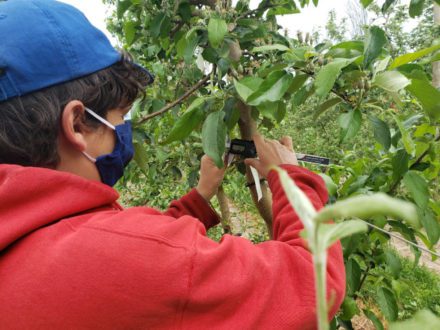Mar 8, 2021Can computerized modeling drive precision bloom thinning?
The latest apple research results from the farmer-driven Northern New York Agricultural Development Program evaluate how well computerized modeling programs help growers determine when to begin thinning the bloom in their orchards.
Three commercial apple orchards in Peru, New York (Clinton County) participated in the Northern New York Agricultural Development Program (NNYADP) on-farm thinning trials in 2020: Everett Orchards, Forrence Orchards, and Northern Orchard.
The latest results report is posted on the Northern New York Agricultural Development Program (NNYADP) website.
“Thinning apples at bloom is an orchard practice with the greatest potential to increase apple size for the current year’s harvest as well as to promote a return bloom the next year,” says project leader Michael Basedow, a Cornell Cooperative Extension tree fruit specialist.
The optimal number of fruit per tree where yield, apple size, and fruit quality are well-balanced to bring the greatest economic return to the grower varies by the variety of apple. Two of the 2020 NNYADP in-orchard trials were in Honeycrisp variety orchard blocks; the third in a Gala block.
“Bloom thinning is a promising approach for managing crop load and is used extensively by apple growers in Washington State, but it is a difficult practice to perform as it requires precise timing of the thinning material applications,” Basedow notes.
Basedow’s research is applying the use of computerized modeling to determine when growers should apply materials that help reduce the crop load to allow the trees to produce apples of optimal quality and size and in numbers that also allow the trees to efficiently bloom again the next year. The Pollen Tube Growth Model estimates the amount of time between pollination and fertilization of apple flowers to help growers plan for a first thinning application.
To gauge how well the trees have responded to the thinning process throughout the growing season, Basedow is evaluating the use of the Fruit Growth Rate (FGR) model that estimates the amount of crop still on the trees after each thinning application. This helps determine is additional thinning is needed.
In the 2020 trials, the FGR modeling over-predicted the remaining crop load by 10 percent at the Gala site and by 160 percent at one of the Honeycrisp site. The research team is evaluating factors, such as cold temperature damage to buds in the spring and fruit drop during period of high heat stress and drought, for possible influence on the FGR model’s accuracy. Both of these weather-related conditions occurred in northern New York in 2020.
This spring’s orchard bloom will let the growers know how well the timing of their applications in 2020 functioned to aid the return bloom for 2021.
Earlier precision apple management research results reports are posted in the Research: Horticulture section of the NNYADP website.
Funding for the Northern New York Agricultural Development Program is supported by the New York State Legislature and administered by the New York State Department of Agriculture and Markets.















